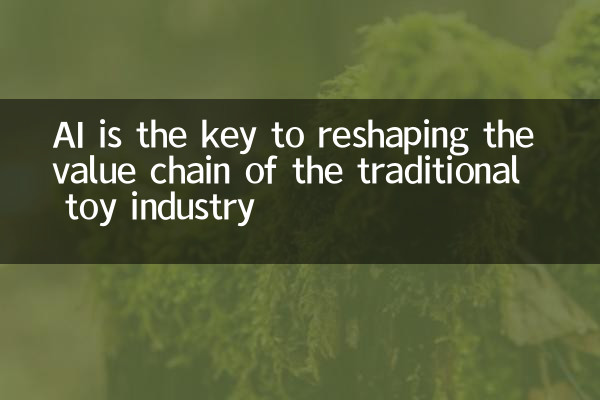AI is the key to reshaping the value chain of the traditional toy industry
In recent years, the rapid development of artificial intelligence (AI) technology is profoundly changing many industries, and the traditional toy industry is no exception. From intelligent companion robots to personalized customized toys, AI is reshaping the value chain of the toy industry and bringing new growth points to the industry. The following is a review of popular topics and hot content on the entire network in the past 10 days. Combined with structured data, analyzing how AI has become the key to the transformation of the toy industry.
1. Current status of AI application in the toy industry

AI technology has penetrated into multiple links in the toy industry, including design, production, sales and user experience. The following are the classification statistics of popular AI toy products in the past 10 days:
| Product Type | Representative Brand | Main functions | Popularity Index (1-10) |
|---|---|---|---|
| Intelligent companion robot | Anki, U.S. must-choose | Voice interaction, emotional recognition | 9 |
| Educational programming toys | Lego, Makeblock | Programming learning, logic training | 8 |
| AR/VR interactive toys | Disney, Sony | Combining virtual and real, immersive experience | 7 |
| Personalized custom toys | Hasbro, Barbie | AI generation design, 3D printing | 6 |
2. How AI reshapes the value chain of the toy industry
1.Design and development:AI algorithms can analyze children's behavioral data and optimize toy design. For example, predict popular elements through machine learning and shorten product development cycles.
2.Production and manufacturing:Smart factories use AI to achieve automated production and reduce labor costs. The following are the application data of AI in the production process in the past 10 days:
| Application scenarios | Improve efficiency | Cost reduction |
|---|---|---|
| Intelligent quality inspection | 30% | 25% |
| Supply Chain Optimization | 20% | 15% |
| Predictive maintenance | 40% | 30% |
3.Sales and Marketing:AI-driven personalized recommendation systems are changing the toy sales model. For example, by analyzing user portraits, accurately push toys suitable for children of different ages.
4.User experience:Smart toys provide a richer interactive experience through natural language processing and computer vision technology. The following are users’ feedback statistics on AI toys:
| Function | Satisfaction (%) | Repurchase intention (%) |
|---|---|---|
| Voice interaction | 85 | 75 |
| Educational content | 90 | 80 |
| Personalized service | 78 | 65 |
3. Challenges and future trends
Although AI brings many opportunities to the toy industry, it also faces challenges such as data privacy, technical thresholds and ethical issues. In the future, the combination of AI and toy industry will show the following trends:
1.Application of emotion computing technology:By identifying children's emotional states, a more considerate companionship experience is provided.
2.The rise of meta-universe toys:Toys that combine virtual and reality will become a new hot spot.
3.Sustainability:AI will help design more environmentally friendly toy materials and packaging.
4. Conclusion
AI technology is reshaping the value chain of the traditional toy industry from multiple dimensions, bringing unprecedented innovation opportunities to the industry. Enterprises need to actively embrace this change and explore more possibilities for combining AI with toys while protecting user privacy and following ethical norms. In the future, smart toys will not only become a good partner for children's growth, but will also become one of the important scenarios for the implementation of AI technology.